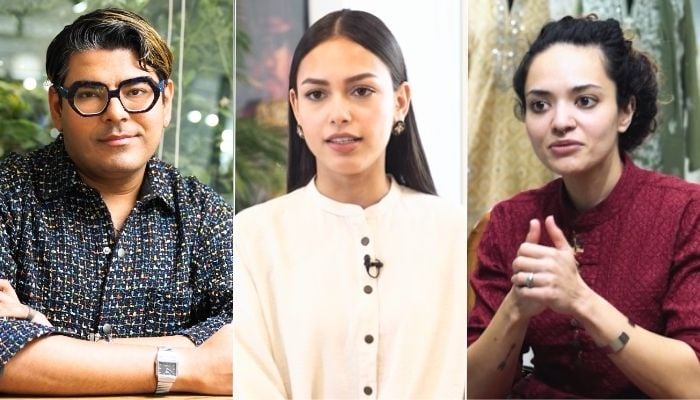
When one of Pakistan’s leading clothing brands unveiled its latest campaign with an AI-generated model, the internet went into overdrive. Some hailed the move as forward-thinking – a glimpse into the future of fashion – while others dismissed it as a cold, cost-cutting gimmick that stripped the human essence of style.
As the digital age reshapes creative industries around the world, artificial intelligence is quickly becoming a silent collaborator, from design boards to digital campaigns. But the question remains: at what cost? Can AI really replace the human touch that defines fashion? To explore this, geodigital I spoke to leading voices in Pakistan’s fashion scene – designers, stylists and models – each of whom brought a nuanced perspective to a debate that is just beginning.
‘AI is the future, but it is not always possible to identify with perfection’
Parishae Adnan, a Karachi-based fashion designer, said AI is not something to be afraid of.
“If we look at the current scenario, yes: human models are being replaced by AI, and AI tools are being used in the fashion industry like in any other sector,” he said. “There is nothing wrong with using AI as a model. It is the future.”
However, even as she embraces technology, Parishae recognizes her emotional limitations.
“The only problem I find with AI models is that they are too perfect. Humans are not. If you look closely at that campaign, the model’s skin, lighting and location are flawless, almost unreal. That’s why it doesn’t connect with us emotionally.”
Parishae, who also integrates AI tools into his business operations, believes in combining innovation with practicality.
“AI helps me identify which of my stores need replenishment and how much. It would take a human time to calculate that, but AI gives me answers in seconds. My team still runs it, but AI saves us time and effort.”
Still, he believes the future depends on balance, not replacement.
“I think AI will not replace humans in the fashion industry, but people need to understand how to control it, how to limit its use,” he added. “That’s where the real challenge lies.”
‘If AI reduces costs, what’s the problem?’
The debate is not only creative: it is economic. Pakistan’s fashion industry, like much of the country, is struggling with inflation and rising production costs. From thread to fabric, prices have nearly doubled in the last two years.
“In Pakistan we are facing an economic crisis. The cost of living, and even death, has doubled,” Parishae said with a wry laugh. “If a brand uses AI models to reduce costs, what’s the problem? If I find something cheaper and better, I will do it. People think brands are overcharging, but if you buy the fabric and sew it yourself, it will cost you almost the same.”
‘AI models can’t walk the ramp or feel emotion’
Erica Robin, Pakistan’s first representative at Miss Universe in 2023, was among those who received the viral images of the campaign in their inbox.
“A lot of people texted me pictures from the campaign,” he said. “I thought it was innovative – it’s great to experiment with technology. However, I think AI tools can be used in better ways than replacing humans with AI models.”
Erica believes that human models bring something irreplaceable to the frame.
“We work eight hours a day, sometimes during the day, sometimes at night. I’m not saying that others don’t do it, but modeling is hard work. The advantage of working with a human model is that you don’t have to keep giving instructions. Once I understand the concept, I get to work: I know my job.”
For Erica, modeling is not just posing: it’s acting.
“Being a model, I don’t think we charge too much,” she said. “If we’re getting results, we get paid for the effort we put in.”
“The silhouette, the walk, the expression – that’s something only a human being can bring to life. You can activate a machine, but you can’t make it feel. Audiences connect emotionally when they see familiar faces like Hania Aamir or Mahira Khan wearing a suit. That connection drives them to buy. Now imagine a catalog full of AI models: would buyers feel the same?”
For Erica, AI can help, not replace.
“It’s a tool, not a substitute. If we eliminate human models, what happens to photographers, stylists and makeup artists? The entire creative chain collapses.”
‘Fashion without emotion is fashion without soul’
Veteran stylist Tabesh Khoja, known for his award-winning work in the industry, echoes this sentiment.
“When people browse a brand’s catalog, they feel emotions: they imagine wearing those outfits,” he explained. “If they see a model that’s not real, that connection fades.”
Khoja worries that the rise of AI could deepen unemployment in an already fragile creative economy.
“If technology helps people grow in their careers, that’s great. But if it takes away their jobs, what situation are we in?”
Still, he acknowledges that AI will open up new functions in the long term.
“We will see more companies, assistants and AI experts entering the world of fashion. But AI can’t dry hair or do makeup. It can tell you what color suits you, but it can’t feel what that color makes you feel.”
For Khoja, fashion is more than aesthetics: it is an emotional experience.
“Fashion is based on emotion, from creation to execution. The makeup artist, the photographer, the stylist, everyone adds their human touch. If you take away the soul, what is left? A fashion industry without emotion is an industry without soul.”
As global brands with digital clones of models face backlash, Pakistan’s fashion world is now treading the same path. The industry is at a crossroads, balancing innovation with identity and efficiency with empathy.
AI could make campaigns faster, cheaper and visually flawless, but as designers, models and stylists all agreed, fashion is not just about how you look; It’s about how you feel. And that, at least for now, remains wonderfully – and irreplaceably – human.



